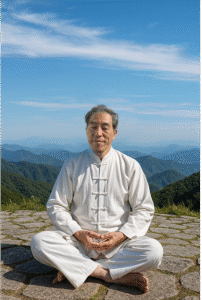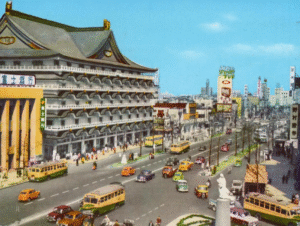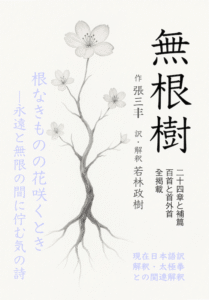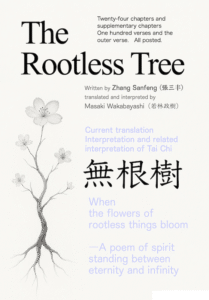紹介
若林 政樹
 タオの哲理にある無極。全てのものを含み、全てのものが無いという無極。無極から陰陽が生まれ太極となり、四象・八卦と全ての現象を世に送り出していきます。写意画は、その無極から始まるこの現象を絵画として書き上げていく芸術であり、符であり、空間においては風水となります。
タオの哲理にある無極。全てのものを含み、全てのものが無いという無極。無極から陰陽が生まれ太極となり、四象・八卦と全ての現象を世に送り出していきます。写意画は、その無極から始まるこの現象を絵画として書き上げていく芸術であり、符であり、空間においては風水となります。
中国武当山の道家の老師から、無根樹の哲理の解釈と共に、符図として写意画を学び、全ての詩と首に対する作品が完成しました。その詩の心と、気・リズム・流れ・沈黙・余白といった、見えざるものを表現します。私の作品が、中国伝統の風水のように空間に氣(き)を通し、調律するタリスマン的アートとして、空間と心に静かな波紋を広げることを願っています。今後も、詩や物語などを現在版写意画として描く創作活動を行っていきます。

1957年、大阪に生まれる。母方の祖母は女浪曲師の幸枝若・祖父は大阪歌舞伎座や全日本プロレス協会などの興行やスポーツを取り仕切る、博徒組織の代貸(ナンバー2)であった。
祖父の博徒組織が運営する、全日本プロレス協会の道場や歌舞伎座で、幼い頃からプロレス・剣術・芸能などのプロの指導を受ける。また、大阪新歌舞伎座の看板絵師より幼い頃から指導を受け、写意画の基礎を身につける。
高校時代に柳生新陰流を学ぶ。成年時に、祖父の護衛であった武当山の太極拳師範から、太極拳を始めとする太極功、老子、無根樹などの哲理、写意画の技法、考証学などを専門的に一対一で学び、30才の頃に印可を受ける。この頃から師から学んだ技法で、無根樹の哲理を深く理解するために、無根樹に関する写意画を描き始める。
この写意画に強い興味を示す政治家や企業家が現れたが、この時期にパンダ金魚の事業が急激なブームとなり、写意画に関しては一時中断した。
 20代で広告企画会社の代表取締役として活動し、1988年には香港で譲り受けた「パンダ金魚」を日本に紹介、テレビや新聞雑誌に多く出演し、事業展開のために東京に移転し、大手企業の事業企画なども手がける。
20代で広告企画会社の代表取締役として活動し、1988年には香港で譲り受けた「パンダ金魚」を日本に紹介、テレビや新聞雑誌に多く出演し、事業展開のために東京に移転し、大手企業の事業企画なども手がける。横浜に移転後、主婦の消費者全国組織を設立運営、30代から絶えず、太極理論の研究・太極拳の養生や理論・武道の伝承を始め、太極拳・気功教室などを開催している。

2025年に、40年近くの時間をかけて、無根樹24章と100首の解釈を全編完成し、無根樹を各章と各首を符図として描いた250点を超える写意画を完成させ、日本で初めてとなる無根樹完全解釈の出版と、符図としての写意画作品を発表した。
今後、東洋哲学や東洋医学、太極功・気功などに関する書籍の出版や、哲理詩を中心にした写意画を描く、コンセプトアート作品を随時発表していく。
出版物
簡化24式太極拳で骨の髄まで練り上げる技法/世界一美しい「簡化24式太極拳」/太極拳史真伝(上中下巻)/新型コロナ対太極拳/老子と主婦の対話(道・徳編)/楊式85式太極拳/無根樹24章・100首/The Rootless Tree・24Chapters・100Verses
Copyright © MASAKI WAKABAYASHI. All rights reserved.
